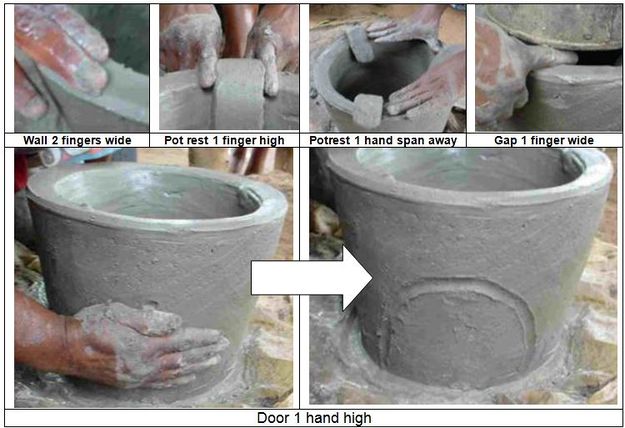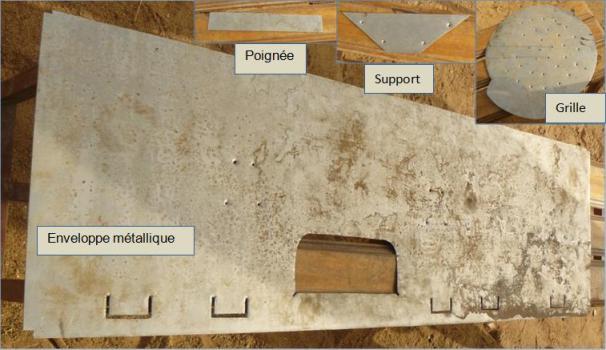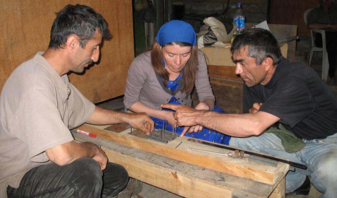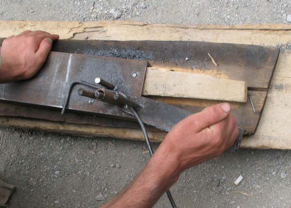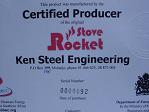Quality Assurance of Improved Cookstoves (ICS)
Cooking Energy System | Basics | Policy Advice | Planning | Designing and Implementing ICS Supply | Designing and Implementing Woodfuel Supply | Climate Change | Extra
The Need for Quality Assurance of ICS
Why is there a need for “quality assurance of improved cook stoves”?
This question can be answered from a “program”, a “market” and a “production” perspective.
Quality Assurance as a Need from a “Program” Perspective
The general intention of an ICS program is to improve the situation of biomass cooking through the introduction of an improved technology that performs better than the baseline technology which it is supposed to replace. At the onset of such an intervention, stoves therefore have to be developed or adapted which have a better quality as compared to the most commonly used stoves of the target group.
In the past, this “improvement” was mainly related to the specific fuel consumption or in respect to the durability of stoves. In recent years, emissions are also an important factor to be considered. From a customer point of view, looks, convenience of use as well as safety are also important dimensions of “quality” of an ICS.
The Promotion of these “improved cook stoves” is based on a result chain in which it is assumed that the better performing cook stoves are developed, produced, sold at an affordable price to and are used by households. The use of better quality stoves in households leads to the intended immediate impacts on fuel savings, emission reductions and is contributing to the overarching goals of poverty reduction, less deforestation and health benefits.
However, this chain is based on the assumption that the stoves which are used in the households are of the same quality as the ones which have been developed at the onset of this result chain.
Quality Assurance as a Need from a “Market” Perspective
In a market based dissemination approach, producers or traders have to convince customers that they should spent their little cash for a stove. As all potential customers already have some means of cooking in their house, the producer must advertise the improvements (e.g. fanciness, fuel savings, color) which convince the customer. It must be “trendy” to have an ICS at home, something people are proud of and tell their neighbors. This will be easier if the new stove is produced and advertised as a “brand” rather than as an individual masterpiece. If all ICS look different and perform differently, it is difficult for the customer to decide which stove is the best for him or her. But if there are only 2-3 different brands to be compared, for which each ICS of the same brand looks the same and performs equally well, both advertisement as well as decision making is much easier. From a project perspective supporting market development, it is important that the brand will be associated with the product and the producers and not with the project. For this to happen, there is need for actions to ensure that the potential customers have no reason to doubt that if they buy a stove of a particular brand they will get an improved cook stove of a promised quality. In other words: for the market it is important that stoves are offered with a constant/continuous good (high) quality level.
Quality Assurance as a Need from a “Production” Perspective
Experiences in many countries have shown that the quality of locally produced stoves is subject to many influencing factors:
- Artisanal production systems are more vulnerable to quality deviations than industrial production systems
The production of improved cook stoves in rural areas is often a (part time) artisanal (off season) activity. This may have consequences on the quality of the stoves produced if no counter-measures are taken.
If “producing and selling stoves” does not provide for a living, producers tend to involve themselves in the ICS sector as an “off-season income generating activity”. Due to the low frequency and low magnitude of stove production, there might be a danger that they are lacking routine in stove construction, which might undermine the quality of the produced stoves.
If “selling stoves” does provide for a good living, untrained “copycats” may get interested and produce stoves which look like the official brand, but which are not adhering to the required specifications. As customers may not know the difference, these copycats can spoil the market.
Qualified producers may be tempted to improve their income from stove production. As “raising prices” is not appreciated by the customers, the alternative is to reduce the cost of production through the selection of cheaper materials, the use of less materials (smaller dimensions) and the reduction of working time (short cuts in the production). Hence, producers might change dimensions of the stove due to customer demands.
As a result of any of these three effects, the produced stoves do no longer represent the original quality of stove. It is therefore important to employ activities to assure the quality of the ICS.
- Product development is never “concluded”
The development of a new “improved cook stove” is often seen as the “first step” which is followed by the training of artisans and the establishment of a supply-demand system. However, it is a common observation that “product development” is never really concluded. The first commercially produced stoves may show some “teething problems” which have to be rectified through modifications of the stove design. These loops of design alteration may lead to confusions on what the actual “quality” of “the ICS” is. Producers as well as customers may get confused if too many different variations of the same stoves are on the market at the same time.
It is therefore important to conclude at one point the technology development process for a brand and define its specifications. Any further modification will then be released under a new brand or new model of the same brand.
- Frame conditions for stove production are changing
Even if artisans are intending to follow the recommended specifications, they might be forced to deviate from the right practice if important building materials such as metal sheets of a specific thickness, cement of a certain quality, or bricks of a particular isolative property are not available on the market.
It is important that all factors of an ICS value chain are analyzed before the specification of a marketable stove model are defined to minimize such difficulties.
The Forms of Quality Assurance of ICS
“Assuring” the quality of ICS has to be understood as a process along the dissemination chain.
Depending on the production and dissemination structures following steps should be considered:
1. The definition of technical specifications which define the technical design of a product
2. The standardization of the production process to minimize deviations in the production process.
3. Pre-sale selection of the stoves - only quality stoves should enter the market.
4. Labels to inform customers about stove quality.
5. Certification of producers
6. Compulsory standards promote the adherence to quality standards if they can be enforced.
7. After sale quality assurance
1. The definition of technical “specifications”
A precondition for quality assurance is the definition of the “quality” which shall be assured. Commonly, it is not the “stove quality” which is described, but rather the dimensions, properties of materials to be used and sometimes the kind of processing technology to be applied. These details are documented in a stove fact sheet including design sketches. Test results are often complemented to prove that stoves of these specifications can achieve specific performance results under standardized conditions (e.g. water boiling test). It is important to keep original stove models in a stove library as a reference.
It is important to note that these “specifications” are commonly not “standards”, unless they have been approved by the National Bureau of Standards. Therefore, the term “standard” should be used carefully in order to avoid confusions.
2. The standardization of the production processes
In order to reduce the possibility of unintended deviations of dimensions in the production process (design drift), there are possibilities to support the producers with measures and tools and measuring methods.
The easiest form is to use anthropometric measures (the size of typical human body parts as shown below[1]) for the measurement of the right dimensions e.g. of a clay stove:
Alternatively, measuring tools can be provided such as bamboo sticks or plates with markers for different dimensions.
Moulds are forms in which the clay can be pressed in order to assume a form which is predefined according to recommendations.
Templates are commonly used for metal stoves. They are used to copy the dimensions of the parts onto a new metal sheet before they are cut accordingly.[2]
Machines can assist the tinsmith to produce metal stoves which are evenly shaped and well connected. Furthermore they reduce labor input and the likelihood of measure failures, when applied properly.
The use of jigs is an important tool to improve the exactness of measurements, when cutting or welding metal.
|
|
|
| The use of jigs for cutting and welding is often new for metal workers. However, the usage of jigs enable a precise cutting, benching, and welding of metal and save working time.[3] | |
| Machines used for the production of a VITA stove in Mauretania[4] | |
Particularly for fixed stoves it is difficult to achieve a defined quality as they are built on site. The use of pre-manufactured parts which are locally assembled is a possibility to reduce design drift[1].
The ultimate choice to assure quality is the promotion of (imported) industrially produced ICS. Here the production process is highly standardized and monitored by the producer.
3. Certification of producers
Another option is a certification process for producers by a program. At the beginning of their career, the stove production of new producers is intensively controlled. Once they have been producing quality stoves for a defined duration, they will receive a certificate from the program or its government partner to verify that they have mastered the business. Thereafter, external quality control will be reduced. However, if they are found to produce poor quality stoves, the certificate can be withdrawn.
Leaflet on certified Institutional Rocket Stove producers in Malawi
4. Pre-sale selection of the stoves
Artisanal production always will result in small or larger deviation from the specifications. However, if artisans are made aware of the importance to maintain a good reputation of their products, they can inspect their stoves critically before the sale and discard those which do not adhere to the specifications. This inspection should already happen during the production process with the individual parts/pieces. If a part/piece is ready, it should be checked and only assembled with other components if it fulfills the quality requirements. This inspection should already happen during the production process with the individual parts/pieces.
Quality check list for Institutional Rocket Stoves in Malawi
At the beginning of a stove intervention, it is commonly the project staff or its collaborating partners who will ensure that no stove is sold which is not respecting the specifications. However, over time this process is handed over to the individual producer or to a group of artisans (e.g. association). The peer review is also a good learning process particularly for new stove producers.
5. Voluntary quality labels
Projects design quality labels which they do only grant to stoves which adhere to quality specifications. The availability of the label ensures the customer that this stove has been checked and is produced according to specifications. The label later on can be handed over to an association of artisans. However, sometimes these labels are faked by other producers.
6. Compulsory ICS standards
Standardization is the ultimate institutionalization of stove quality assurance. The approval and enforcement of standards is a government obligation. But in some countries it is a time and cost intensive process to register such kind of stove standard. It can happen that in the meantime the stove development has advanced and the freshly registered design is no longer produced. It also has to be assessed if there is the capacity to enforce this kind of standard. If other important standards cannot be enforced (e.g. on road safety), how likely is it that this will happen for ICS?
7. After sale quality assurance
Quality assurance of ICS can also be promoted by the users. For this to happen, the users have to be made aware about stove quality aspects and their role. Awareness materials such as posters and leaflets, but also theater play or the training of women groups can promote the awareness of users on the important features of a good quality ICS. Being trained and motivated through these awareness activities, thereafter the social control on a village based stove producer can be a strong mechanism to ensure the production of good stoves. Similarly, traders can be trained to detect properly produced stoves and reject poor stoves from producers. A warranty on stove performance or durability is a way producers can assure customers on the quality of their stove. If the stoves do not perform according to their promises, they offer after sales services to replace or improve the stove. This concept is important particularly for fixed stoves as the customer has no choice but to accept whatever is built in his/her kitchen.
|
Certification of producers and serial numbers of stoves in Malawi[5] |
The Challenges of Quality Assurance of ICS
There are many challenges of quality assurance. The main important ones are:
1) Who is in charge of quality assurance?
2) Which sanctions are available and can be enforced if low quality stoves are produced?
3) Sustainability of quality assurance
4) Corruption – And who is controlling the controller?
5) Quality assurance of a stove does not ensure good cooking energy services
1) Who is in charge of quality assurance?
On the first look this question might be easy to answer. We (as a project) bring in a new technology and train “our” producers. Hence we have to make sure that they produce a good stove by controlling their products.
But for this to work we have to create a structure which clearly defines this responsibility and which provides sufficient capacities and resources to allow for controls in a meaningful quality and frequency.
Alternatively, quality control can be organized through various other actors:
• Local NGOs
• Government extension workers
• Contractors / consultants
• National research institutions
• Stove associations Which actor is best qualified and equipped to take over quality assurance tasks depends on the local conditions. It has to be considered, whether the quality assurance tasks can be charged and can therefore be a source of income for an actor. So far, most of these actors do not have sufficient own financial and human resources to administer this service without external support. Another avenue is to include users and producers into the quality assurance system through awareness of the importance of good quality products.
2) Which sanctions can be enforced if low quality stoves are produced?
Stove producers are actors of the private sector. As long as quality criteria are defined within a project context and not as a legally binding standard, these actors can actually produce and sell whatever they want. The administration of sanctions against poorly manufactured stoves is something to be thought of at the onset of the planning process.
There are a number of options how proper specifications can be enforced within the informal framework of an intervention:
- Certification documents for producers can be withdrawn if the producer is starting to deviate from agreed upon practices;
- Producers can be expelled from the program based marketing interventions;
- Producers can be expelled from the association of producers, loosing hence access to marketing events or access to material supply chain;
- User associations can make their members aware of quality problems of specific producers;
- Clay stove producer groups can refuse to accept poorly moulded stoves to be entered into the jointly operated kiln;
- Tools for the production of stoves can be given by the program under the condition of adherence to specific standards of productions. It can be specified that violation of code of conduct can lead to the withdrawal of the assets;
- The strongest sanction that can enforce the production of quality control is the awareness of the customers. If potential buyers of ICS are aware of the differences between good and poorly produced stoves and have access to different producers (competition between producers), they can promote quality assurance by only buying good quality stoves. It is important to develop and agree upon these mechanisms BEFORE the start of the promotion so that producers familiarize with these regulations as part of their initial training.
3) Sustainability of quality assurance
Many measures to assure quality are working well as long as a project is financing it. However, margins on stove sales are so small that it is mostly not feasible to finance quality assurance measures through the stove sector. If governments are too poor to afford these services, it remains a responsibility of the producers and the users to maintain the quality of the ICS. In recent years, carbon financing is seen as a possibility to ensure quality control through external sources. However, it remains to be seen how long these sources of financing will be available.
4) Corruption – And who is controlling the controller?
In large scale programs, the implementation is subcontracted to a large number of local partner organizations. The quality control in such kind of interventions cannot be done through the staff of the program but is commonly part of the contract of the partner organization. As these organizations have vested interest in large dissemination figures, the control might be insufficient. This may lead to the question “Who is controlling the controller?” Even if there is a third party contracted to verify the results of the partner organization, the question still remains the same, but on an aggregated level.
5) Quality assurance of a stove does not ensure good cooking energy services
Even if we manage to ensure that the ICS used by a household is 100% according to specification, it can still happen that the kitchen is full of smoke and the cooking is taking a very long time. This is due to the fact that the stove technology is only one part of the cooking energy system.
If wet firewood or cow dung is used for cooking, or if users place too much firewood into the chamber, these households might still complain about the poor performance of the stove. In the assessment of user’s complaints it is therefore very important to distinguish between the technology aspect, the fuel aspect and the user behavior impact on the cooking performance.
-> Further reading: Peracod (2011), Presentation
Production Systems and Quality Management
Examples of different production systems and the respective implications for quality management can be found in the following articles:
- Overview
- Decentralized Stove Production Systems
- Centralised Stove Production Systems
- Quality Management
- Components of a Good Quality Control System
Further Information
- Andrea Reikat: GTZ FAFASO: Le Systeme de suivi, Download Presentation - FAFASO: Le système de suivi
- GTZ ProBEC: Institutional Stoves in Malawi, Download institutional stoves mw-2007.pdf Presentation - PROBEC Institutional Stoves in Malawi
References
This article was originally published by GIZ HERA. It is basically based on experiences, lessons learned and information gathered by GIZ cook stove projects. You can find more information about the authors and experts of the original “Cooking Energy Compendium” in the Imprint.
- ↑ 1.0 1.1 Picture: Deutsche Gesellschaft für Internationale Zusammenarbeit (GIZ) GmbH, Poverty-oriented basic energy services (HERA)
- ↑ Picture: Templates for the production of a VITA stove in Mauretania, Source: Presentation of Blandine Schaffner for GIZfckLR
- ↑ Picture: S. Nienhuys (2010): Consultancy on Cooking Stoves and Heating Systems Khorog, Tajikistan
- ↑ Presentation of Blandine Schaffner for GIZ
- ↑ Deutsche Gesellschaft für Internationale Zusammenarbeit (GIZ) GmbH



